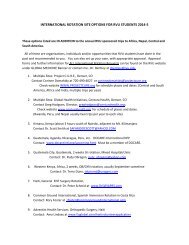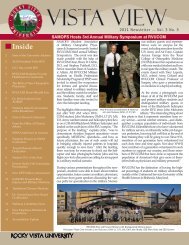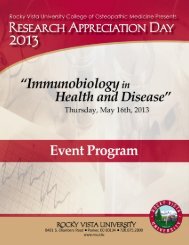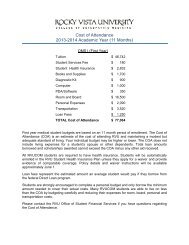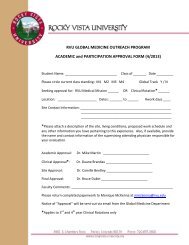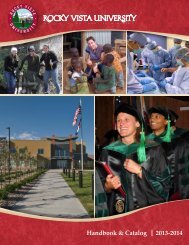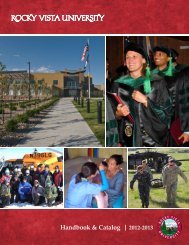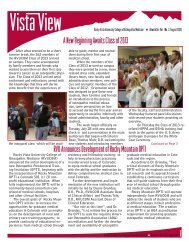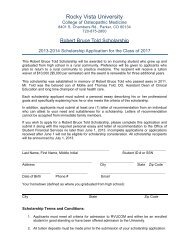Vol. 2, No. 6, July 2010 - Rocky Vista University
Vol. 2, No. 6, July 2010 - Rocky Vista University
Vol. 2, No. 6, July 2010 - Rocky Vista University
Create successful ePaper yourself
Turn your PDF publications into a flip-book with our unique Google optimized e-Paper software.
C<br />
O R<br />
Y<br />
K<br />
V<br />
I S<br />
T A A<br />
<strong>Vista</strong> View<br />
U U<br />
N<br />
I<br />
V<br />
F O U N D E D 2 0 0 6<br />
E<br />
R<br />
T<br />
I<br />
S<br />
Y<br />
RVU’s Class of 2013 Broadens Banquet Tradition<br />
Newsletter <strong>Vol</strong>. 2 <strong>No</strong>. 6 <strong>July</strong> <strong>2010</strong><br />
The RVU Class of 2013 held its Gala on the evening<br />
of May 28, <strong>2010</strong>, the final day of classes before summer<br />
break. This awards presentation, dinner and dance<br />
raised the bar from last year’s event in scale, programming,<br />
noise and even raucous energy.<br />
The grand ballroom of the Hyatt Regency Hotel in Centennial,<br />
Colorado was again the scene for this year’s<br />
event.<br />
Although it was designated a “Gala” by the Class of<br />
2013 program organizers, the event was also affectionately<br />
dubbed the medical school “prom”. Regardless of<br />
what the event may have been called, it was an opportunity<br />
for everyone to dress up and wind down from another<br />
rigorous academic year. It was also a chance for<br />
the <strong>University</strong> to recognize students who had demonstrated<br />
outstanding academic performance and service<br />
and for the Class of 2013 to recognize faculty and staff<br />
who they felt enhanced their experience at the <strong>University</strong>.<br />
It was also a time for the inaugural Class of 2012<br />
to say goodbye to everyone.<br />
The group of nearly 400 people began to assemble<br />
outside the hotel ballroom at 6:00 PM in anticipation of<br />
the evening’s activities. At about 7:00 PM the ballroom<br />
doors opened and all were seated for dinner. Within<br />
minutes after everyone settled in their seats, dinner<br />
was served and the evening’s program began. As photos<br />
Class of 2012 Top 10% in Academic Standing: Paul Moullet, Jeremy Kenison,<br />
Bobby Bahadorani, Rick Carlson, Morgan Campbell, Brittany Ganser,<br />
Tyler Anstett, Anderson Hu & Slade Bigelow<br />
of students from both classes flashed on two large<br />
screens at the front of the room, various student and<br />
administration speakers commented on the events of<br />
the past academic year and the prospects for the future.<br />
The awards began with recognition of the top academic<br />
performers from each class and continued with additional<br />
student awards and awards presented by the<br />
students to <strong>University</strong> staff and faculty members. The<br />
specific award categories, along with all of the student<br />
award winners who were honored for <strong>2010</strong>, are listed on<br />
page 8 of this issue of <strong>Vista</strong> View.<br />
The evening ended with dancing to music<br />
provided by a DJ and more conversation in<br />
the lobby outside the ballroom. The dancing<br />
and conversation continued until all left<br />
around 11:00 PM. It was another great evening<br />
and the culmination of the <strong>University</strong>’s<br />
second complete academic year. It was also<br />
the beginning of a transition for both classes of<br />
students and for the <strong>University</strong> staff as everyone<br />
went their separate ways to prepare for<br />
the challenges of board exams, summer break<br />
and the beginning of the next<br />
academic year.<br />
Class of 2013 Top 10% in Academic Standing: Casey Bitting, Erika Penabaker,<br />
Brent Ennis, Michael Allender,Thomas Githens, Bonnie Hunt, Lauren Tobin & Tyler Voigt<br />
1<br />
1
<strong>Vista</strong> View<br />
Over the past month or so, we have all seen many<br />
of our second year students in the library, in the<br />
third floor study rooms and in their favorite reading<br />
‘nooks’. When you ask them what they’re up to, the<br />
universal response is almost always, “I’m studying<br />
for the Boards.” Here at RVUCOM, students must<br />
take their osteopathic board exams prior to beginning<br />
patient contact in their third year. Passage of<br />
the boards is a requirement to continue at the third<br />
year level.<br />
What really are the “Boards”, and what does that<br />
mean? It’s much more than a rite of passage that<br />
all medical students must go through. The mission<br />
of the National Board of Osteopathic Medical<br />
Examiners (NBOME) is to protect the public by providing<br />
the means to assess competencies for osteopathic<br />
medicine and related health professions.<br />
The role of protecting the public is something they<br />
take very seriously. We as a <strong>University</strong> take it seriously<br />
as well.<br />
Dean’s <strong>No</strong>tes<br />
Ever since their foundation in 1934, the NBOME has<br />
dedicated their organization to patient safety. This is<br />
currently accomplished by a series of examinations<br />
usually taken at the end of the second year and during<br />
the fourth year of medical school. These examinations<br />
are called respectively the Level I and Level II Boards.<br />
Passing the Level I and Level II examinations are requirements<br />
for graduation at RVUCOM. A Level III examination<br />
is taken during the post-graduate years as a<br />
condition of licensure.<br />
The NBOME examinations are the primary pathway<br />
by which osteopathic physicians apply for licensure to<br />
practice osteopathic medicine and surgery. A passing<br />
score on these examinations indicates that the candidate’s<br />
medical knowledge and clinical skills have met a<br />
national standard. The COMLEX-USA examination sequence<br />
is accepted for licensure in all 50 states.<br />
Student performance on the examination is also another<br />
metric by which they are judged, and in turn indicates<br />
how good a job we are doing as a medical school. Application<br />
to residency programs around the country will<br />
often begin their screening process of resident selection<br />
based upon performance on the Board examinations. A<br />
passing but low score may prevent a graduating medical<br />
student from getting accepted into a competitive program.<br />
A high score may open doors for candidates as<br />
well.<br />
2<br />
As a school we are judged based upon the collective<br />
performance of our students on these examinations. A<br />
high pass rate and strong performance overall by our<br />
students is indicative of a strong medical school curriculum.<br />
As a new school, our current second year class is<br />
the first group of students ever to take this examination.<br />
In many respects, this is the first real test for RVUCOM<br />
faculty, staff and administration as well. Rest assured,<br />
we will be judged by the overall performance on these<br />
exams nationally.<br />
Unlike many other schools around the country, we will<br />
be very transparent about our board scores. All students<br />
are required to have taken this examination prior<br />
to their first clinical rotations in year III. I am hopeful that<br />
we will have the data on all the exams no later than September<br />
of this year, and I will release our ‘report card’<br />
once all the information is all received. Until then, let’s<br />
wish our medical students all the best as they prepare<br />
for this important examination.<br />
Bruce D. Dubin, D.O., J.D., FACOI<br />
Dean, CAO, <strong>Rocky</strong> <strong>Vista</strong> <strong>University</strong><br />
College of Osteopathic Medicine<br />
1
<strong>Vista</strong> View<br />
RVU’s College of Osteopathic Medicine Hosts Pre-Orientation for New Students<br />
In <strong>July</strong>, new students arrive on<br />
campus for orientation. They<br />
may be excited, enthusiastic<br />
and perhaps even a little<br />
frightened as they approach<br />
the beginning of a new academic<br />
challenge in a new environment<br />
and often in a new<br />
city and state. They also come<br />
with many questions regarding<br />
life at RVUCOM, life as a medical<br />
student, life in Colorado,<br />
housing, finances and so on.<br />
In order to give students and their<br />
families a head start in answering<br />
some of these questions, RVUCOM<br />
held a Pre-Orientation in April. More<br />
than 140 Class of 2014 students, family<br />
and friends were in attendance.<br />
The special event was organized and<br />
hosted by the RVUCOM Department<br />
of Student Services and was designed<br />
to give incoming students an<br />
early introduction to medical school<br />
and the Colorado community. Students<br />
were invited to come to pose<br />
questions, learn about medical school<br />
and take care of some of the details of<br />
setting up a new home in Colorado.<br />
The day began with a continental<br />
breakfast sponsored by the United<br />
States Army. Then, students and their<br />
guests attended morning presentations<br />
from members of the College of<br />
Osteopathic Medicine administration,<br />
faculty and current students that gave<br />
them an overview of the medical<br />
school curriculum, students’ perspectives<br />
on life as a medical student and<br />
a sample of the typical classroom experience.<br />
They also learned about<br />
the innovative RVUCOM Health Professions<br />
Loan program and the typical<br />
costs of attendance.<br />
A catered Mexican luncheon was<br />
provided for the group by the United<br />
States Navy. In addition to afternoon<br />
presentations, the incoming students<br />
were also able to visit a number of<br />
booths set up on campus that provided<br />
information about rental housing,<br />
home purchasing, the military’s medical<br />
student scholarship program and<br />
the quality of life in the Parker,<br />
Colorado community. Members<br />
of the RVUCOM Student Ambassadors<br />
along with other student<br />
volunteers provided building<br />
tours and assisted with logistics.<br />
Some students opened their<br />
homes to visitors for tours.<br />
For visitors with an interest in<br />
sports, that evening there was<br />
an outing to a Colorado Rockies<br />
major league baseball game<br />
at beautiful Coors Field in downtown<br />
Denver. For those who decided not to<br />
attend the game, there was the option<br />
to enjoy any of the many attractions,<br />
restaurants, theaters and other venues<br />
available to visitors throughout<br />
the Denver area.<br />
Although this was the first event of<br />
its kind for RVUCOM and also considering<br />
that attendance at the event<br />
was optional for the incoming class<br />
members, the response to this Pre-<br />
Orientation event was so enthusiastic<br />
that it may be continued as an annual<br />
event. It seems to have emerged as<br />
an ideal vehicle to help new students<br />
become acclimated to the <strong>University</strong><br />
and its surrounding communities before<br />
they are required to arrive to begin<br />
classes.<br />
3<br />
1
<strong>Vista</strong> View<br />
RVU Sponsors Parker’s Independence Day Celebration<br />
RVU and the Town of Parker co-sponsored the <strong>2010</strong> Independence<br />
Day Celebration. The celebration which was<br />
themed “Let Freedom Sing” was held on Saturday, <strong>July</strong> 3<br />
at Parker’s Salisbury Park. In addition to a variety of food<br />
and gift vendors, the celebration featured performances<br />
by several local bands that provided a wide range of music<br />
for the thousands of people who occupied nearly every<br />
square inch of available space in the park.<br />
RVU Interim President, Robert R. Roehrich, Ph.D., had<br />
the opportunity to address the crowd twice during the<br />
event. He first spoke during a break in the music where<br />
he briefly discussed RVU’s educational mission, its history,<br />
goals for the future and its place in the Parker community.<br />
Later, Dr. Roehrich had the opportunity to speak to<br />
the group a second time following an address by Parker’s<br />
Mayor, David Casiano, and preceding the beginning of a<br />
spectacular Independence Day fireworks display.<br />
Scott Coduto and Megan Young help staff the RVU exhibit table<br />
Julie Rosenthal, Executive Director of Admissions and<br />
Marketing; Stephanie Osborne, Admissions Recruiter/Diversity<br />
Specialist; Adrian Clark, Director of Communications<br />
and Public Relations; along with incoming first year<br />
medical students Scott Coduto and Megan Young, staffed<br />
an RVU exhibit table at the event. During “Let Freedom<br />
Sing”, they distributed more than a thousand RVU branded<br />
gifts, talked with visitors entering the celebration and<br />
fielded questions about the <strong>University</strong>, its osteopathic<br />
medical school and the new <strong>Rocky</strong> <strong>Vista</strong> Health Center.<br />
Breakfast with Dr. Roehrich<br />
RVU Interim President, Robert R.<br />
Roehrich, Ph.D. recently sponsored<br />
two informal breakfast meetings<br />
with employees. Both breakfasts<br />
which were open to all employees<br />
and held in the <strong>University</strong>’s Board<br />
Room included a broad selection<br />
of pastries, fruit, coffee and orange<br />
juice. Employees were invited to<br />
attend at their leisure throughout<br />
the morning for each event.<br />
The extended hours of the two<br />
events, Dr. Roehrich said, were<br />
specifically designed to give everyone<br />
an opportunity to attend<br />
the breakfasts. “The theme of<br />
4<br />
these breakfasts is about encouraging<br />
dialogue and communication<br />
throughout the <strong>University</strong>. People<br />
from different work groups or departments<br />
can talk with each other<br />
in a comfortable setting and perhaps<br />
even begin collaborating on<br />
new ideas or resolving problems.<br />
The breakfasts give me an opportunity<br />
to get to know everyone and<br />
to talk with people informally. <strong>University</strong><br />
employees also get the opportunity<br />
to talk with me outside of<br />
a formal office setting.”<br />
“So far”, Dr. Roehrich continued, “I<br />
think that I’ve received some excellent<br />
recommendations and some<br />
very interesting ideas as a result<br />
of my participation in these breakfasts.<br />
Of course, the other more<br />
tangible benefit of these breakfasts<br />
is the food. We all know that conversations<br />
somehow seem just a<br />
little more productive when they<br />
are accompanied by good food.”<br />
Dr. Roehrich plans to have at least<br />
one of these breakfasts each quarter<br />
with the next breakfast currently<br />
scheduled for the fall after students<br />
have returned for classes.
<strong>Vista</strong> View<br />
A Journal of Wilderness Medical Education By Thomas N. Told, D.O. FACOFP dist.<br />
The culmination of the first six months of<br />
study for the inaugural Rural and Wilderness<br />
Medicine Track at RVUCOM was<br />
held at Seely Ranch in remote <strong>No</strong>rthwest<br />
Colorado.<br />
The ranch was originally homesteaded by<br />
Peter Fibbs, an Irish immigrant who came<br />
to America at the end of the 19th century<br />
with his future bride-to-be. He left her in<br />
New York where they landed and traveled<br />
to the Yampa Valley frontier in Colorado to<br />
establish their new home. He cleared the<br />
land and built a large two story rustic log<br />
Irish castle for his soon-to-be wife. When<br />
he returned to New York to marry and bring<br />
his new wife home, he found that in his<br />
absence she had married someone else.<br />
Heartbroken, he came back to his ranch<br />
and never married.<br />
In 1920, David R. Seely, a cowboy and<br />
sheep rancher from Castledale, Utah, was<br />
delivering livestock to the area and met<br />
Mr. Fibbs who offered the ranch for sale.<br />
Mr. Seely raised the money to purchase<br />
the ranch and moved to the home where<br />
the fifth generation of the Seely family lives<br />
today.<br />
The area around the ranch has a varied<br />
terrain that ranges from sage brush covered<br />
slopes to lofty alpine meadows dotted<br />
with pine and aspen groves. It is the perfect<br />
place to see all types of wildlife including<br />
large herds of elk and an occasional<br />
bear or mountain lion.<br />
On Thursday, May 20th, ten RVUCOM students,<br />
Dr. Ben Schnell and I piled into two<br />
four-wheel drive vehicles for the five-hour<br />
trip from Parker that crosses the continen-<br />
tal divide twice, winds past the slopes of<br />
Steamboat Springs and ends up at the foot<br />
of Horse Mountain.<br />
We settled into two of the homestead cabins<br />
and then explored the ranch before<br />
supper. Meals at Seely ranch are crafted<br />
by Ann Seely, a true artisan in the kitchen<br />
who has fed legions of hungry hay crews<br />
and elk hunters over the years. That<br />
first evening we discussed the next day’s<br />
course materials and the syllabus that<br />
had been prepared by Dr. Schnell. We<br />
also discussed how people survive in the<br />
wilderness in addition to the philosophy<br />
of successful search-and-rescue operations.<br />
Medical preparedness, assembly of<br />
a medical kit and resources available to the<br />
wilderness physician were reviewed.<br />
Each subsequent evening, Dr. Schnell<br />
would lead extensive discussions covering<br />
a variety of wilderness medicine topics<br />
including treatment of hypothermia and<br />
frostbite, physiology and pathophysiology<br />
of injuries and preventive measures.<br />
These discussions extended well beyond<br />
two hours. We also learned fishhook removal<br />
and wilderness pain control including<br />
the use of regional blocks for fracture<br />
and laceration treatment. We covered<br />
swift water rescue and the basic skills<br />
needed before we went to the field for trials.<br />
These formal lectures helped us organize<br />
the next day’s activity.<br />
Whenever the weather was not favorable,<br />
we returned to our study hall for work on<br />
bandaging and splinting and making litters.<br />
Friday May 21st was a beautiful, warm<br />
sunny day for our first lesson in horsemanship<br />
and packsaddle training. After a brief<br />
breakfast discussion on horse safety, we<br />
all headed to the horse corral to learn the<br />
proper way to catch and halter our mounts.<br />
Once all the horses were caught, we took<br />
them to the saddling area of the barn and<br />
learned the proper way to tie up a horse for<br />
saddling. Grooming techniques in preparation<br />
for saddling were covered in detail.<br />
The students learned what to look for<br />
during saddling to prevent injury to themselves<br />
or to their horses. Once the horses<br />
were saddled, they learned the proper way<br />
to mount and techniques for riding safely in<br />
the mountains. For the rest of the trip, students<br />
were allowed to catch their horses<br />
during their free time and ride where they<br />
wished.<br />
The other portion of the horsemanship experience<br />
was to learn the proper technique<br />
for using a pack saddle. The pack saddle<br />
is much more complicated than the western<br />
saddle and there are many more steps<br />
to remember. Each student learned how to<br />
pack medical gear to prevent damage and<br />
load the horse so the pack rides evenly.<br />
They also learned techniques of working<br />
with both horses and mules when using<br />
them to carry loads into the back country.<br />
The warm afternoon proved to be a perfect<br />
time to do swift water rescue techniques.<br />
We moved our white water class to a<br />
small, but very swift and swollen stream<br />
near the ranch.<br />
The students practiced the skills discussed<br />
the night before on how to avoid rocks and<br />
dead fall trees called “strainers”. They<br />
learned techniques to free a victim’s feet<br />
that may be lodged in swift water. They<br />
then used the strong swimmer technique<br />
to get a rope to the other side of the swollen<br />
stream and anchor it for passage of<br />
a high line to transport a litter. The students<br />
passed a Stokes Stretcher across<br />
the stream loaded with rocks to simulate<br />
a patient. At one point the large hemp<br />
rope broke and plunged the load into the<br />
stream. The students were impressed at<br />
how much force was exerted on the litter.<br />
(continues on next page)<br />
5<br />
1
<strong>Vista</strong> View<br />
It took a tremendous amount of strength to<br />
retrieve the litter from the raging stream.<br />
After many techniques at stream crossings<br />
we found that hanging on to a static overhead<br />
line was the best way to cross the<br />
stream. The students practiced numerous<br />
crossings until they were comfortable with<br />
the process. Everyone gained a new respect<br />
for the power of flooding mountain<br />
streams.<br />
Friday evening the topic was compass<br />
reading and orienteering, as well as emergency<br />
signaling. Lessons involved using<br />
a compass and a map for navigation in<br />
the wilderness. The students also learned<br />
proper techniques for signaling aircraft.<br />
Journal (continued)<br />
Saturday morning was grey and rainy. The<br />
students used their time to discuss lightning<br />
safety and the types of lighting injuries<br />
suffered by people and animals. The<br />
rainy and foggy afternoon was perfect for<br />
learning to build natural shelters in the wild.<br />
Mostly natural materials were used, supplemented<br />
by plastic bags, parachute cord<br />
and duct tape to create spaces to shelter<br />
ourselves from the elements. Students<br />
built one person and multi-person dwellings<br />
and periodically checked them for<br />
leaks and dampness. Various design patterns<br />
were tested and the students learned<br />
what looks good in a book may not always<br />
be the best in the field.<br />
Students also tested various water purification<br />
methods and built a solar still using<br />
a clear plastic sheet, a rock, a cup and field<br />
greens.<br />
Sunday morning, May 23rd, was foggy<br />
and cold, but later the weather improved<br />
enough for the students to test some of the<br />
skills they had learned during the past few<br />
days. Most of the class saddled horses<br />
and rode while other students practiced<br />
maneuvering all-terrain vehicles up canyons<br />
and over small hills.<br />
At a luncheon debriefing on the final day of<br />
the course, everyone agreed that the week<br />
in the wilderness at Seely Ranch had been<br />
an experience they would remember for<br />
some time. It had been the perfect opportunity<br />
for a real world test of what they had<br />
been taught in the curriculum.<br />
For more than two weeks<br />
temperatures in and around<br />
Denver had been mixed. The<br />
days had alternated between<br />
cloudy, partly cloudy and sunny.<br />
There had been rain, chill<br />
and even a few snow flurries.<br />
In other words, we had been<br />
experiencing the usual eclectic<br />
weather patterns that typically characterize what some affectionately<br />
call “springtime in the Rockies”.<br />
Amazingly, however, the day that the <strong>University</strong> chose to<br />
dedicate its new Memorial Garden was bright, sunny and<br />
clear with a temperature that hovered near the mid-sixties.<br />
The garden had been created to honor the memory of RVU<br />
Class of 2013 student, Brandon Trusell, who died tragically<br />
in an automobile accident along with his sister during the<br />
2009 holiday break.<br />
Brandon’s classmates decided to plant a tree in his honor<br />
on the RVU campus. <strong>University</strong> officials decided to use this<br />
gesture from the students as a basis for developing memorial<br />
garden that would enhance the prominence of the tree<br />
planting and establish a lasting addition to the campus. The<br />
garden was designed by Chuck Flood who heads up Facilities<br />
and most of the work of developing and planting the garden<br />
was accomplished almost single-handedly by Andrew<br />
Flood of the Facilities department.<br />
Memorial Garden Dedicated<br />
,<br />
At a ceremony dedicating the garden, RVU students and<br />
staff joined with Brandon’s parents and brothers to view the<br />
garden and the tree planting. In one of his final official duties,<br />
outgoing RVU Interim President, D. Robert Black, Esq.<br />
led the ceremony and commemorated the tree planting as a<br />
celebration of Brandon’s life. Dean of Student Services, Michael<br />
Martin, Ph.D., Assistant Professor Laura Mohr, Ph.D.<br />
and several students also spoke during the ceremony.<br />
At the end of the ceremony Brandon’s parents were asked<br />
to unveil a plaque that was affixed to a large rock at the base<br />
of a young maple tree. The inscription on the plaque read:<br />
“This tree grows here in memory of the life of Brandon Trusell<br />
RVUCOM Class of 2013”. Brandon’s father who is also<br />
an osteopathic physician thanked the <strong>University</strong> for honoring<br />
his son and his family with the garden.<br />
It is up to those of us who remain at the <strong>University</strong> to make<br />
sure the tree and the garden receive the proper care they<br />
need to flourish. As<br />
the years progress and<br />
the <strong>University</strong> grows<br />
in size and scope we<br />
can watch the tree expand<br />
its branches and<br />
produce beautiful red<br />
leaves every autumn<br />
as each new class of<br />
students arrives on<br />
campus.<br />
6<br />
1
<strong>Vista</strong> View<br />
D. Robert Black, Esq. Says Farewell to RVU<br />
During a reception and luncheon<br />
held in his honor, D.<br />
Robert Black, RVU’s Interim<br />
President for nearly<br />
18 months, said farewell to<br />
employees and students.<br />
Delivering a brief message<br />
to the group, he talked of<br />
how he had been positively<br />
changed by his experience<br />
at the helm of the <strong>University</strong><br />
and about the growth that<br />
the school has experienced<br />
since he arrived on the campus.<br />
He admitted that his<br />
decision to leave had been<br />
a difficult one because he<br />
felt that he had made many<br />
friends since he had arrived at the school. However, he<br />
added that it was time for him to return to Florida in order<br />
to spend more time with his wife and teenage daughter.<br />
Mr. Black recounted some of the changes that the university<br />
had experienced during his tenure and indicated<br />
that he believed the <strong>University</strong> was now well-positioned<br />
for growth and that the current management team leading<br />
the <strong>University</strong> was knowledgeable, experienced and committed<br />
to the success of RVU.<br />
At the end of Mr. Black’s remarks,<br />
Dr. Thomas Saban, Vice President<br />
of Finance and Administration,<br />
talked about some of the<br />
work Mr. Black had done “behind<br />
the scenes” to improve operations<br />
at the <strong>University</strong> during its<br />
formative period.<br />
Robert R. Roehrich, Ph.D., the<br />
then incoming interim president,<br />
thanked Mr. Black for his contributions<br />
to the <strong>University</strong>, for his<br />
accessibility to students and staff<br />
and for arranging a smooth transition<br />
of leadership.<br />
The Employee Events Committee<br />
that organized the event presented Mr. Black with a<br />
parting gift on behalf of the <strong>University</strong> – a large, framed<br />
photograph of the building with signatures of <strong>University</strong><br />
employees on the matting surrounding the picture.<br />
Upon his departure, Mr. Black said that he would like to<br />
remain connected to the <strong>University</strong>, most likely on a special<br />
project or contract basis. He admitted that since he<br />
had become a part of the <strong>University</strong>, it would always remain<br />
a part of him and that he hoped to continue to be<br />
involved with RVU in one way or another.<br />
Social Committee Members Erin Palazzolo, Patty Gordon, Erica Whatley,<br />
Holly Kaspar & Linda Cairns, along with Dr. Robert Roehrich, new<br />
Interim President, present a signed plaque to D. Robert Black.<br />
7<br />
1
<strong>Vista</strong> View<br />
Student & Faculty Award Winners<br />
Top 10% of Class – 2012 (listed alphabetically)<br />
Tyler Anstett Bobby Bahadorani Slade Bigelow Morgan Campbell<br />
Rick Carlson Brittany Ganser Anderson Hu Jeremy Kenison<br />
Kristen Knowles Lauren Majcher Danielle McDonald Jerry McQuain<br />
Paul Moullet<br />
Scott Reeder<br />
Top 10% of Class – 2013 (…as of the end of HBMH - listed alphabetically)<br />
Michael Allender Casey Bitting Brent Enniss Joshua Garfein<br />
Thomas Githens Bonnie Hunt Tyler Hurst Eric Mast<br />
Erika Penabaker Sheena Ray Justin Stoll Lauren Tobin<br />
Katie Truettner Jon Vaux Tyler Voigt Kayleigh Zerr<br />
Department Awards – One award – chosen by faculty, based on grade in course, attitude, work ethic & support of classmates.<br />
FSM (first-year student)<br />
OPP Student (second-year student/culmination)<br />
PCM Student (second-year student/culmination)<br />
Research Recognition<br />
Ben Foreman<br />
Jeremy Kenison<br />
Heather Katz<br />
Cecily DuPree & Brent Barbour<br />
Student Leader – based on involvement, leadership roles & contributions to RVUCOM; must be in good academic standing<br />
Class of 2012 Winner: Rick Carlson<br />
Class of 2103 Winner: Josh Gazzetta<br />
Service Award – based on involvement, leadership, & contributions to service efforts; must be in good academic standing<br />
Dan Sheffield<br />
Military Award – based on involvement, leadership & contributions to military medicine/impact at RVU<br />
Matt Malivuk<br />
Student Doctor Congeniality – based on attitude, work ethic & support of fellow students<br />
Class of 2012 Winner: Kay Yien<br />
Class of 2013 Winner: Amanda Jo Cameron<br />
Class Clown – based on attitude & contribution to class well-being<br />
Class of 2012 Winner: Kasey Welch<br />
Class of 2013 Winner: Russell Pieper<br />
Faculty Award Winners<br />
A.T. Still Award for Excellence in Clinical Medicine<br />
William Osler Award for Excellence in Biomedical Sciences<br />
RVUCOM Administrative Faculty Award<br />
Unsung Hero Award<br />
Dr. Joseph Stasio<br />
Dr. Walter Buck & Dr. Richard Garrison<br />
Lisa Bolstad - Pod C<br />
Matt Griebel – IT<br />
New Employees<br />
Dr. Qamrul Choudhury – Assistant Professor of Physiology<br />
Dr. Jennifer Herman – Assistant Professor of Physiology and Anatomy<br />
Dr. Amber Ondricek – Assistant Professor of Molecular Biology<br />
Dr. Jason Wells – Associate Professor of Structural Medicine<br />
Published by the<br />
<strong>Rocky</strong> <strong>Vista</strong> <strong>University</strong><br />
Admissions & Marketing Department<br />
8401 S. Chambers Rd.,<br />
Parker, CO 80134<br />
303-373-2008<br />
Editor: Adrian R. Clark, Director,<br />
Communications and Public Relations<br />
Graphic Design: Holly E. Kaspar<br />
Marketing & Admissions Coordinator<br />
8<br />
1



